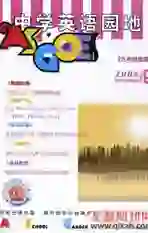中考动词时态考查热点透视
2008-10-16姜经志
姜经志
动词时态是中考英语的考查热点之一。本文以近几年全国部分省市的中考试题为例,对常考查的动词时态作一归纳,希望能对同学们的学习有所帮助。
[考点一] 一般现在时
[点拨] (1) 概念:表示经常性、习惯性的动作,表示现在的状态或特征,还表示普遍真理或客观事实。(2) 与之连用的时间状语有always,often,usually,sometimes,every day,once a week等。(3) 适用的动词种类有:系动词;行为动词。(4) 注意:如果主语是第三人称单数时,其谓语动词末尾要加-s或-es;在时间状语从句和条件状语从句中,可用一般现在时表示将来时间。例如:
1. Every year many foreigners________to China to learn Chinese.
A. have come B. comes
C. came D. come
[答案与简析] 答案为D。every year通常与一般现在时连用。主语many foreigners含复数意义,故谓语动词为复数形式。
2. Your teacher will be unhappy if you________to school late.
A. come B. will come
C. are coming D. came
[答案与简析] 答案为A。主句中will be表示将来时间,在if引导的条件状语从句中,谓语动词用一般现在时表示将来时间。
3. —Is your father a doctor?
—Yes,he is. He________in Town Hospital.
A. has worked B. had worked
C. works D. worked
[答案与简析] 答案为C。由答语“Yes,he is.” 我们可知,接下来的句子中应该用一般现在时。
4. A large number of students in this school________from the country. They work very hard.
A. come B. comes C. came D. coming
[答案与简析] 答案为A。后一句“They work very hard”说明动作发生在现在时间,那么前一句也应指现在时间。主语a large number of students意为“许多学生”,含复数意义,故谓语动词应为come。
5. Tom is strong and he________to school every day.
A. walked B. walks
C. will walk D. has walked
[答案与简析] 答案为B。前一分句中的谓语动词是is,后一分句的时间状语是every day,由此我们可以判断,此句中的谓语动词应为一般现在时,空白处填walks。
[考点二] 一般过去时
[点拨] (1) 概念:表示过去某一时间发生的动作或存在的状态,还表示过去习惯性、经常性的动作或行为。(2) 与之连用的时间状语有yesterday,last week,... ago,just now,in 1998等。(3) 适用的动词形式:系动词和行为动词的过去式。注意:动词过去式的不规则变化。例如:
1. —How was your weekend?
—Great! We________a picnic by the lake.
A. have B. are having
C. had D. will have
[答案与简析] 答案为C。根据常识,若别人问你“周末过得怎么样?”,那一定是在问你已经过去的那个周末。再看问句中的was,说明答句中要用一般过去时。
2. —Excuse me. You cant take photos here. Look at the sign! It says “NO PHOTOS”.
—Sorry,I________it.
A. dont see B. didnt see
C. wont see D. havent seen
[答案与简析] 答案为B。本句中虽没有明显的时间状语,但从句意理解,显然答话人没看到“禁止拍照”的标志是刚才发生的事,故空白处的行为动词应为一般过去时的否定式。
3. —Wheres the cake I made this morning?
—We________it,mom. Can you make another one for us?
A. ate B. eat
C. will eat D. were eating
[答案与简析] 答案为A。妈妈问:“我今天早上做的蛋糕在哪里?”孩子答道:“妈妈,我们把它吃了。你能给我们再做一个吗?”可见,吃蛋糕的事是过去发生的,空白处应填ate。
[考点三] 一般将来时
[点拨] (1) 概念:表示将要发生的动作或存在的状态以及打算、计划或准备做某事。(2) 与之连用的时间状语有tomorrow,next week,in two hours,soon等。(3) 适用的动词形式为“will/shall + 动词原形”;“be going to + 动词原形”。(4) 注意:come,go,arrive,leave,start等动词的现在进行时形式可以表示将要发生的动作。例如:
1. —Jim,can you help me to wash the dishes?
—Sorry,Dad. I________to the shop.
A. go B. went
C. am going D. have been
[答案与简析] 答案为C。爸爸问:“吉姆,你能帮我洗盘子吗?”儿子答道:“对不起,爸爸,我要去商店。”由此可知,“我要去商店”是将要发生的动作。
2. Frank________a film if hes free next Saturday.
A. see B. saw
C. has seen D. will see
[答案与简析] 答案为D。if从句中的时间状语next Saturday是将来时间。依照逻辑推断,主句中的谓语动词应为一般将来时。
3. —Do you know when Dr White________for dinner this evening?
—No,but I think he________when he is free.
A. will come;comes B. will come;will come
C. comes;comes D. comes;will come
[答案与简析] 答案为B。问句中when引导的是宾语从句,this evening指将来时间;答句中when引导的是时间状语从句,其中的is free是一般现在时表示将来时间,据此,空白处应填will come。
[考点四] 现在进行时
[点拨] (1) 概念:表示现阶段或说话时正在发生的动作或存在的状态。(2) 与之连用的时间状语有now,these days,at this moment等。(3) 适用的动词形式为“助动词be (am,is,are) + 动词的现在分词”。(4) 注意:现在进行时常与look或listen等提示词连用,也可以通过上下文的情景来确定。例如:
1. —Whats your brother doing in his room now?
—He________a kite.
A. make B. is making
C. made D. will make
[答案与简析] 答案为B。提问者说:“你弟弟正在房间里干什么?”回答者说:“他在做风筝。”根据此句意我们可以推断,答句中应该用现在进行时。
2. —Shall we go shopping now?
—Sorry,I cant. I________my shirts.
A. wash B. washes
C. washed D. am washing
[答案与简析] 答案为D。问话者说:“我们去购物好吗?”回答者说:“对不起,我不能去。我正在洗衬衫。”根据句意我们可以推断,空白处应填am washing。
[考点五] 过去进行时
[点拨] (1) 概念:表示在过去某一时刻或某一阶段内正在进行的动作。(2) 与之连用的时间状语有at that time,at this time yesterday,from 8 to 10 last night等及由when等引导的谓语动词是一般过去时的时间状语从句等。(3) 适用的动词形式为“was/were + 动词的现在分词”。例如:
1. I________my homework while my parents________TV last night.
A. did;have watched B. was doing;were watching
C. had done;were watching D. would do;were watching
[答案与简析] 答案为B。从句意看,while引导的时间状语从句中的动作和主句中的动作是同时进行的,从时间状语last night我们可以推断,主句和从句的谓语动词都要用过去进行时。
2. My sister________her book in the classroom when her teacher came in.
A. read B. reads
C. was reading D. is reading
[答案与简析] 答案为C。从句意看,when从句中的动作是发生在主句动作进行的过程中。从句中用一般过去时,主句应该用过去进行时。
3. I was too excited to fall asleep that night as I________of seeing Yang Liwei,the first Chinese astronaut.
A. am thinking B. thought
C. was thinking D. think
[答案与简析] 答案为C。主句用一般过去时,要表示过去某一时刻或某一段时间正在发生的事情,从句中就应该用过去进行时。
[考点六] 现在完成时
[点拨] (1) 概念及时间状语:表示过去发生的动作对现在造成的影响或结果,此时常与already,before,just,yet等副词连用;表示开始于过去,持续到现在的动作或状态,此时常与“for + 段时间”或“since + 点时间或从句”连用。(2) 适用的动词形式:“have/has + 动词的过去分词”。(3) 注意:短暂性动词不能与“for + 段时间”或since引出的时间状语连用,但有时也能根据意思上的需要将这些短暂性动词转化成相应的延续性动词。此时,也能与这些时间状语连用。例如:
1. —Kitty,will you go to see the film Cold Mountain this evening?
—No,I wont. I________it already.
A. saw B. have seen
C. see D. will see
[答案与简析] 答案为B。根据答句句末的副词already判断,句子的谓语动词应用现在完成时。
2. Gone with the Wind is a well-known novel. She________it twice.
A. read B. is reading
C. reads D. has read
[答案与简析] 答案为D。该句意为“《飘》是一部非常著名的小说,她已经看过两遍了”。根据后面的twice可以判断,句子的谓语动词应用现在完成时。
3. —Havent I told you to do your homework as carefully as you can?
—Yes,but I________fewer mistakes than I usually do.
A. was making B. have made
C. will make D. had made
[答案与简析] 答案为B。问话者说:“难道我没有告诉你做作业时要尽可能地细心?”答话者说:“你说过,但我出的错误已经比平时少多了。”此句侧重于目前的情况,故空白处应填have made。
4. —Has the match started?
—Started? Finished! Guo Yue________the match.
A. is winning B. wins
C. will win D. has won
[答案与简析] 答案为D。问话者说:“比赛开始了吗?”答话者说:“开始?已经结束了!郭跃赢了。”说明比赛发生在过去,现在郭跃已赢过球了。故此处应用现在完成时。
5. The life we were used to________greatly since 1992.
A. change B. has changed
C. changing D. have changed
[答案与简析] 答案为B。since引导的短语通常与动词的现在完成时连用。The life为句子的主语,谓语动词应为单数形式has changed。we were used to是定语从句,修饰The life。
[考点七] 过去将来时
[点拨] (1) 概念:表示从过去某一时间看将要发生的动作或存在的状态。(2) 适用的动词形式为“would + 动词原形”或“was/were going to + 动词原形”。(3) 与之连用的时间状语有the next day,the following month等。例如:
—The train is leaving right now,but David hasnt arrived yet.
—Well,he said he________here on time.
A. came B. will be
C. would come D. can be
[答案与简析] 答案为C。答语是一个含有宾语从句的复合句,这是从主句he said表示过去的角度来描述他将要按时到这儿来。
[考点八] 过去完成时
[点拨] (1) 概念:表示过去某一时间以前发生的动作或行为,或表示过去某动作之前已经完成的动作或行为,即指“过去的过去”。(2) 与之连用的时间状语有by the end of last year (week,month...)等介词短语或before,when等引导的表示一般过去时的时间状语从句。(3) 适用的动词形式为“had + 动词过去分词”。例如:
—Why didnt you go to the movie yesterday?
—Because I________it before.
A. had watched B. have seen
C. have watched D. had seen
[答案与简析] 答案为D。“看电影”中的看,用see表示。see这一动作发生在went to the movie这一动作之前,故用过去完成时。
